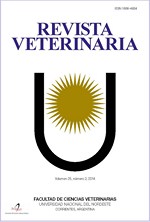Efecto de la densidad de alojamiento y la zona del galpón sobre indicadores de bienestar en pollos parrilleros
DOI:
https://doi.org/10.30972/vet.3326188Palabras clave:
Bienestar animal, Condiciones ambientales, Producción comercialResumen
El objetivo de este trabajo fue evaluar el efecto de la disminución de la densidad de alojamiento y de la zona del galpón sobre lesiones en almohadilla plantar, tarso y suciedad de plumas ventrales de pollos de engorde criados en invierno. El trabajo se realizó en una granja comercial en el noreste de la provincia de Santa Fe, Argentina. Se alojaron 54.000 pollos de engorde en lotes mixtos, en dos galpones oscurecidos, divididos en tres zonas: Paneles, Intermedia y Extractores. Se evaluaron dos densidades de alojamiento: 14 y 12 pollos/m2, estándar y reducida, respectivamente. A los 41 días se valoró la presencia de lesiones y suciedad del plumaje ventral en 120 pollos por zona. Las lesiones de almohadilla plantar registraron diferencias significativas en Extractores (p= 0,0006), Intermedia (p= 0,0002) y Paneles (p< 0,0001), con mayoría de lesiones 1 y 2 en Intermedia y Paneles con densidad estándar. Las lesiones de tarso no fueron significativas en Extractores (p= 0,1107), sí en Intermedia (p= 0,0235) y Paneles (p< 0,0001), ambas, con más lesiones tipo 2 en la densidad estándar. En suciedad de plumas hubo diferencias significativas en Extractores (p= 0,014), Intermedia (p= 0,01) y Paneles (p< 0,0001), con mayor proporción de plumaje tipo 3 en la densidad estándar. Las variables evaluadas dan cuenta del cambio favorable en la situación de bienestar alcanzada mediante la reducción de la densidad de alojamiento en pollos de engorde.Descargas
Citas
Bailie CL, Ijichi C, O’Connell NE. 2018. Effects of stocking density and string provision on welfare-related measures in commercial broiler chickens in windowed houses. Poult Sci 97 (5): 1503-1510. https://doi.org/10.3382/ps/pey026.
Buijs S, Keeling L, Rettenbacher S, Van Poucke E, Tuyttens FAM. 2009. Stocking density effects on broiler welfare: Identifying sensitive ranges for different indicators. Poult Sci 88 (8): 1536–1543. https://doi.org/10.3382/ps.2009-00007.
Dawkins MS, Donnelly CA, Jones TA. 2004. Chicken welfare is influenced more by housing conditions than by stocking density. Nature 427 (6972): 342-344.
Estevez I. 2007. Density allowances for broilers: where to set the limits? Poult Sci 86 (6): 1265-1272. https://doi.org/10.1038/nature02226.
European Commission. 2007. Council Directive 2007/43/EC of 28 June 2007 laying down minimum rules for the protection of chickens kept for meat production. In: Official Journal, L 182, 12/07/2007, 19-28.
Farhadi D, Hosseini SM, Dezfuli BT. 2016. Effect of house type on growth performance, litter quality and incidence of foot lesions in broiler
chickens reared in varying stocking density. J Biosci Bioeng Biotechnol 5 (1).
Gholami M. 2020. Effects of stocking density and environmental conditions on performance, immunity, carcase characteristics, blood constitutes, and economical parameters of Cobb 500 strain broiler chickens. Ital J Anim Sci 19 (1): 524-535. https://doi.org/10.1080/1828051X.2020.1757522.
Hashimoto S, Yamazaki K, Obi T, Takase K. 2011. Footpad dermatitis in broiler chickens in Japan. J Vet Med Sci 73 (3): 293-297. https://doi.org/10.1292/jvms.10-0329.
Huth JC, Archer GS. 2015. Comparison of two LED light bulbs to a dimmable CFL and their effects on broiler chicken growth, stress, and
fear. Poult Sci 94 (9): 2027-2036. https://doi.org/10.3382/ps/pev215.
Ibrahim RR, Abdel-Azeem NM, Mostafa AS, Emeash HH. 2017. Studies on some welfare aspects of broilers reared under different stocking densities. JAVS 2 (1): 23-34.https://doi.org/10.21608/javs.2017.62137.
Ibrahim SS. 2017. Effect of different stocking densities on the broiler production farms profitability. Alex J Vet Sci 52 (1). https://doi.org/10.5455/ajvs.253215.
Jacob FG. 2016. Risk of incidence of hock burn and pododermatitis in broilers reared under commercial conditions. Braz J Poult Sci 18: 357-362. https: //doi.org /10.1590/1806-9061-2015-0183.
Kjaer JB. 2006. Foot pad dermatitis and hock burn in broiler chickens and degree of inheritance. Poult Sci 85 (8): 1342-1348. https://doi.org/10.1093/ps/85.8.1342.
McWard GW, Taylor DR. 2000. Acidified clay litter amendment. J Appl Poult Res 9 (4): 518-529. https://doi.org/10.1093/japr/9.4.518.
Moreki JC, Magapatona S, Manyeula F. 2020. Effect of stocking density on performance of broiler chickens. Int Journal of Agric and Rural Dev. http://researchhub.buan.ac.bw/handle/123456789/40#.
Musilová A, Lichovníková M, Hampel D, Przywarová A. 2013. The effect of the season on incidence of footpad dermatitis and its effect on broilers performance. Acta Univ. Agric. Silvic. Mendelianae Brun 61: 1793-1798. http://dx.doi.org/10.11118/actaun201361061793.
Petek M, Üstüner H, Yeşilbağ D. 2014. Effects of stocking density and litter type on litter quality and growth performance of broiler chicken. Kafkas Univ Vet Fak Derg 20 (5): 743-748. https://doi.org/10.9775/kvfd.2014.11016.
Shepherd EM, Fairchild BD. 2010. Footpad dermatitis in poultry. Poult Sci 89 (10): 2043-2051. https://doi.org/10.3382/ps.2010-00770.
Škrbić Z, Pavlovski Z, Lukić M. 2009. Stocking density: factor of production performance, quality and broiler welfare. Biotechnol Anim Husb 25 (5-6-1): 359-372. https://doi.org/10.2298/BAH0906359S.
Son JH. 2013. The effect of stocking density on the behaviour and welfare indexes of broiler chickens. J Agric Sci Technol 3 (4A): 307.
Thomas DG. 2004. Influence of stocking density on the performance, carcass characteristics and selected welfare indicators of broiler chickens. N Z Vet J 52 (2): 76-81. https://doi.org/10.1080/00480169.2004.36408.
Descargas
Publicado
Cómo citar
Número
Sección
Licencia
Política de acceso abierto
Esta revista proporciona un acceso abierto inmediato a su contenido, basado en el principio de que ofrecer al público un acceso libre a las investigaciones ayuda a un mayor intercambio global de conocimiento. La publicación por parte de terceros será autorizada por Revista Veterinaria toda vez que se la reconozca debidamente y en forma explícita como lugar de publicación del original.
Esta obra está bajo una licencia de Creative Commons Reconocimiento-NoComercial 4.0 Internacional (CC BY-NC 4.0)










.jpg)
.jpg)



